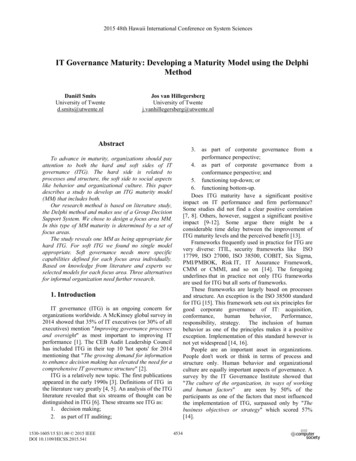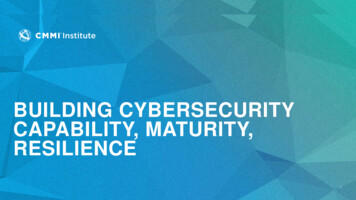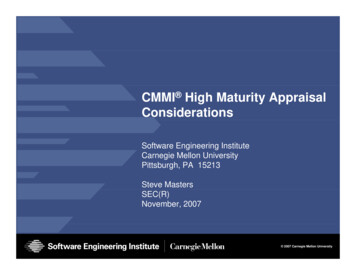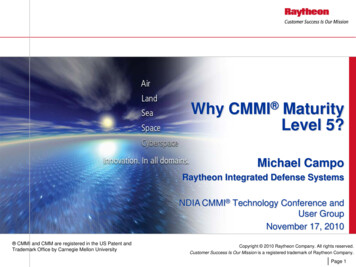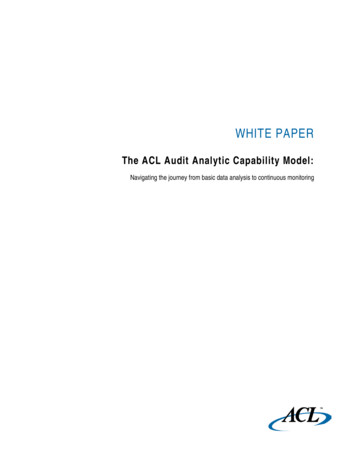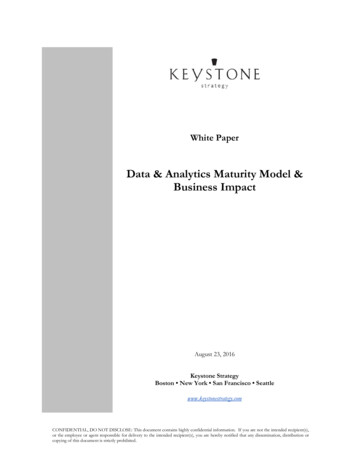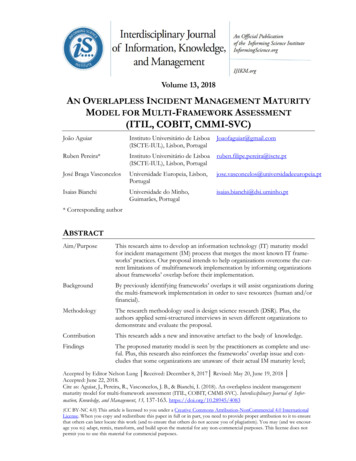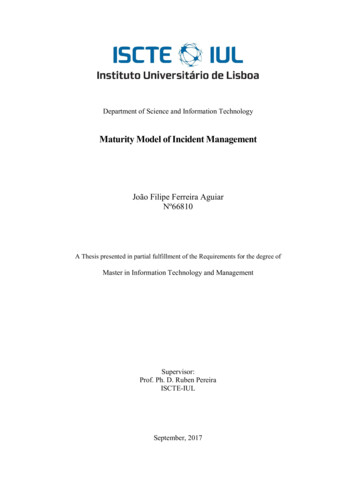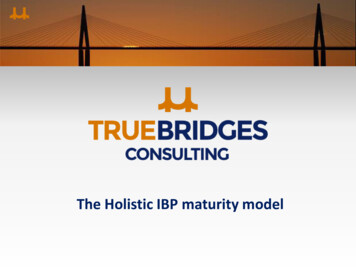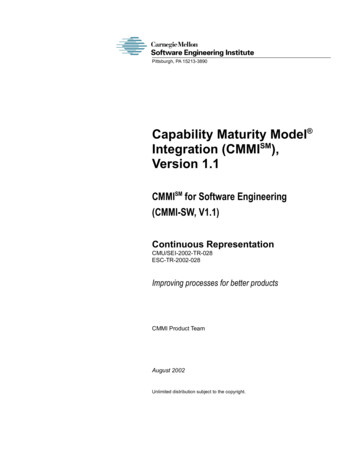
Transcription
Pittsburgh, PA 15213-3890Capability Maturity Model Integration (CMMISM),Version 1.1CMMISM for Software Engineering(CMMI-SW, V1.1)Continuous proving processes for better productsCMMI Product TeamAugust 2002Unlimited distribution subject to the copyright.
This work is sponsored by the U.S. Department of Defense. The Software Engineering Institute is afederally funded research and development center sponsored by the U.S. Department of Defense.Copyright 2002 by Carnegie Mellon University.NO WARRANTYTHIS CARNEGIE MELLON UNIVERSITY AND SOFTWARE ENGINEERING INSTITUTE MATERIAL ISFURNISHED ON AN “AS-IS” BASIS. CARNEGIE MELLON UNIVERSITY MAKES NO WARRANTIES OF ANYKIND, EITHER EXPRESSED OR IMPLIED, AS TO ANY MATTER INCLUDING, BUT NOT LIMITED TO,WARRANTY OF FITNESS FOR PURPOSE OR MERCHANTABILITY, EXCLUSIVITY, OR RESULTS OBTAINEDFROM USE OF THE MATERIAL. CARNEGIE MELLON UNIVERSITY DOES NOT MAKE ANY WARRANTY OFANY KIND WITH RESPECT TO FREEDOM FROM PATENT, TRADEMARK, OR COPYRIGHT INFRINGEMENT.Use of any trademarks in this report is not intended in any way to infringe on the rights of the trademark holder.Internal use. Permission to reproduce this document and to prepare derivative works from this document for internal use isgranted, provided the copyright and “No Warranty” statements are included with all reproductions and derivative works.External use. Requests for permission to reproduce this document or prepare derivative works of this document for externaland commercial use should be addressed to the SEI Licensing Agent.This work was created in the performance of Federal Government Contract Number F19628-00-C-0003 with CarnegieMellon University for the operation of the Software Engineering Institute, a federally funded research and developmentcenter. The Government of the United States has a royalty-free government-purpose license to use, duplicate, or disclose thework, in whole or in part and in any manner, and to have or permit others to do so, for government purposes pursuant to thecopyright license under the clause at 252.227-7013.The following service marks and registered marks are used in this document:Capability Maturity Model CMM CMM IntegrationSMCMMISMIDEALSMSCAMPISMCMM and Capability Maturity Model are registered in the U.S. Patent and Trademark Office.CMM Integration, CMMI, SCAMPI, and IDEAL are service marks of Carnegie Mellon University.
In Memory ofCarolyn Marie Tadyour dedicated team member and friendApril 27, 1958 - November 27, 2001
CMMI-SW, v1.1Continuous RepresentationPrefaceThe Capability Maturity Model Integration (CMMISM) project hasinvolved a large number of people from different organizationsthroughout the world. These organizations were using a CMM ormultiple CMMs and were interested in the benefits of developing anintegration framework to aid in enterprise-wide process improvement.[FM101.T10The CMMI project work is sponsored by the U.S. Department ofDefense (DoD), specifically the Office of the Under Secretary ofDefense, Acquisition, Technology, and Logistics (OUSD/AT&L). Industrysponsorship is provided by the Systems Engineering Committee of theNational Defense Industrial Association (NDIA). [FM101.T102]Organizations from industry, government, and the Software EngineeringInstitute (SEI) joined together to develop the CMMI Framework, a set ofintegrated CMMI models, a CMMI appraisal method, and supportingproducts. These organizations donated the time of one or more of theirpeople to participate in the CMMI project. [FM101.T103]Development HistoryThe CMMI project team has been working to provide guidance thatencourages process improvement in organizations of any structure.[FM101.HDA101.T101]Since 1991, CMMs have been developed for a myriad of disciplines.Some of the most notable include models for systems engineering,software engineering, software acquisition, workforce management anddevelopment, and Integrated Product and Process Development.[FM101.HDA101.T102] CMM, Capability Maturity Model, and Capability Maturity Modeling are registered in the U.S. Patent andTrademark Office.S MCMMI is a service mark of Carnegie Mellon University.Prefacei
CMMI-SW, v1.1Continuous RepresentationAlthough these models have proven useful to many organizations, theuse of multiple models has been problematic. Many organizationswould like to focus their improvement efforts across the disciplineswithin their organizations. However, the differences among thesediscipline-specific models, including their architecture, content, andapproach, have limited these organizations’ ability to focus theirimprovements successfully. Further, applying multiple models that arenot integrated within and across an organization becomes more costlyin terms of training, appraisals, and improvement activities. A set ofintegrated models that successfully addresses multiple disciplines andhas integrated training and appraisal support solves these problems.[FM101.HDA101.T103]The CMM IntegrationSM project was formed to sort out the problem ofusing multiple CMMs. The CMMI Product Team’s mission was tocombine three source models—(1) Capability Maturity Model forSoftware (SW-CMM) v2.0 draft C, (2) Electronic Industries AllianceInterim Standard (EIA/IS) 731, and (3) Integrated Product DevelopmentCapability Maturity Model (IPD-CMM) v0.98—into a single improvementframework for use by organizations pursuing enterprise-wide processimprovement. [FM101.HDA101.T106Developing a set of integrated models has involved more than simplyadding existing model materials together. Using processes that promoteconsensus, the CMMI Product Team has built a framework thataccommodates multiple disciplines and is flexible enough to supporttwo different representations (staged and continuous). [FM101.HDA101.T107]Using information from popular and well-regarded models as sourcematerial, the CMMI Product Team created a cohesive set of integratedmodels that can be adopted by those currently using other CMMs, aswell as by those new to the CMM concept. [FM101.HDA101.T108]During the development phase of the CMMI project, the team’s missionincluded the development of a common framework for supporting thefuture integration of other discipline-specific CMMI models.Furthermore, the team’s mission included the objective of ensuring thatall of the products developed are consistent and compatible with theInternational Organization for Standardization/InternationalElectrotechnical Commission (ISO/IEC) 15504 Technical Report forSoftware Process Assessment. [FM101.HDA101.T109]S MiiCMM Integration is a service mark of Carnegie Mellon University.Preface
CMMI-SW, v1.1Continuous RepresentationCMMI version 0.2 was publicly reviewed and used in initial pilotactivities. Following release of that version, improvement was guided bychange requests from the public review, piloting organizations, andvarious focus group sessions. The CMMI Product Team evaluated morethan 3,000 change requests to create CMMI version 1.0. Shortlythereafter, version 1.02 was released, which incorporated several minorimprovements. As with any release, however, the opportunity for furtherimprovement remained. Version 1.1 accommodates furtherimprovements from early use as well as more than 1,500 changerequests. [FM101.HDA101.T111]AcknowledgmentsMany talented people were involved as part of the product team for theCMMI Product Suite1. Four primary groups involved in this developmenthave been the Steering Group, Product Team, Configuration ControlBoard, and Stakeholders/Reviewers. [FM101.HDA102.T101The Steering Group guides and approves the plans of the ProductTeam, provides consultation on significant CMMI project issues, andensures involvement from a variety of interested communities.[FM101.HDA102.T102]The Product Team writes, reviews, revises, discusses, and agrees onthe structure and technical content of the CMMI Product Suite, includingthe framework, models, training, and appraisal materials. Developmentactivities were based on an A-Specification provided by the SteeringGroup, the three source models, and comments from Stakeholders andSteering Group members. [FM101.HDA102.T104]The Configuration Control Board has been the official mechanism forcontrolling changes to the CMMI models. As such, this group ensuresintegrity over the life of the product suite by reviewing all changes madeto the baseline and approving only those changes that meet the criteriafor the upcoming release. [FM101.HDA102.T113]The Stakeholder/Reviewer group of organizations provided valuableinsight into the early effort that was used to combine the models. Theirreview of multiple versions of the product suite gave the Product Teamvaluable perspectives. [FM101.HDA102.T105]Both present and emeritus members of the four groups involved indeveloping CMMI products are listed in Appendix E. [FM101.HDA102.T111]1See Chapter 3 for a discussion of both “CMMI Product Suite” and “CMMI Framework,” which clarifies thedifference between these two.Prefaceiii
CMMI-SW, v1.1Continuous RepresentationWhere to Look for Additional InformationYou can find additional information, such as the intended audience,background, history of the CMMI models, and the benefits of using theCMMI models, in various other sources. Many of these sources aredocumented on the CMMI Web site, which is located athttp://www.sei.cmu.edu/cmmi/. [FM101.HDA103.T101]Feedback InformationSuggestions for improving the CMMI Product Suite are welcome. Seethe CMMI Web site for information on how to provide feedback:http://www.sei.cmu.edu/cmmi/. [FM101.HDA104.T101]If you have questions, send an email to face
CMMI-SW, v1.1Continuous RepresentationTable of ContentsPrefaceDevelopment HistoryAcknowledgmentsWhere to Look for Additional InformationFeedback Informationiiiiiiviv1 IntroductionAbout CMMI ModelsSelecting a CMMI Model112Representations: Continuous or Staged?Continuous RepresentationStaged RepresentationWhich Integrated Model to Choose?Disciplines: What is Different?Systems EngineeringSoftware EngineeringIntegrated Product and Process DevelopmentSupplier SourcingA RecommendationThe Content of CMMI ModelsTypographical ConventionsSpecific and Generic GoalsSpecific and Generic PracticesReferencesIntroductory Notes, Typical Work Products, and SubpracticesExamplesGeneric Practice ElaborationsDiscipline AmplificationsNumbering SchemeParagraph Identifier Codes2 Model ComponentsStructural OverviewCapability LevelsRequired, Expected, and Informative Components22333344555677777788911111313Model Components14Process Areas14Prefacev
CMMI-SW, v1.1Continuous RepresentationSpecific GoalsSpecific PracticesBase PracticesAdvanced PracticesTypical Work ProductsSubpracticesDiscipline AmplificationsGeneric GoalsGeneric PracticesGeneric Practice ElaborationsReferencesModel Representation ComparisonContinuous Representation ResultsCapability Level ProfilesTarget StagingEquivalent Staging3 Model TerminologyTerminology EvolutionCommon Terminology with Special MeaningAdequate, Appropriate, As NeededEstablish and MaintainCustomerStakeholderRelevant StakeholderManagerProject ManagerSenior ManagerShared rojectProductWork ProductProduct ComponentAppraisalAssessmentTailoring 2626Preface
CMMI-SW, v1.1Continuous RepresentationValidationGoalObjectiveQuality and Process-Performance ObjectivesStandardCMMI-Specific TerminologyCMMI Product SuiteCMMI FrameworkCMMI ModelPeer ReviewOrganization’s Set of Standard ProcessesProcessManaged ProcessDefined ProcessOrganizational Process AssetsProcess ArchitecturesProduct Life CycleOrganization’s Measurement RepositoryOrganization’s Process Asset 031314 Capability Levels and Generic Model ComponentsOverviewInterpreting Specific Goals in the Continuous RepresentationAchieving Capability LevelsCapability Level 0: IncompleteCapability Level 1: PerformedLevel 1 Generic GoalsLevel 1 Generic PracticesCapability Level 2: ManagedLevel 2 Generic GoalsLevel 2 Generic PracticesCapability Level 3: DefinedLevel 3 Generic GoalsLevel 3 Generic PracticesCapability Level 4: Quantitatively ManagedLevel 4 Generic GoalsLevel 4 Generic PracticesCapability Level 5: OptimizingLevel 5 Generic GoalsLevel 5 Generic Practices33333434353536363638384648485051525355555 Framework Interactions58Prefacevii
CMMI-SW, v1.1Continuous RepresentationFour Categories of CMMI Process AreasProcess ManagementThe Scope of Process ManagementBasic Process Management Process AreasAdvanced Process Management Process AreasProject ManagementThe Scope of Project ManagementBasic Project Management Process AreasAdvanced Project Management Process AreasEngineeringThe Scope of EngineeringInteractions Among Engineering Process AreasEngineering Process Areas and RecursionSupportThe Scope of SupportBasic Support Process AreasAdvanced Support Process AreasApplying Generic Practices to Process AreasProcess Area and Generic Practice InteractionOverlap of Generic Practices and Process Management Process Areas6 Using CMMI ModelsInterpreting CMMI ModelsAppraisals and BenchmarkingAppraisal Requirements for CMMIISO/IEC 15504 Compatibility and ConformanceMaking the Transition to CMMIOrganizations with Software CMM ExperienceOrganizations with EIA/IS 731 ExperienceOrganizations New to CMM-Type ModelsTrainingTailoring PerspectivesModel TailoringModel Tailoring PerspectivesModel Tailoring Criteria for Internal Process ImprovementModel Tailoring Criteria for BenchmarkingModel Tailoring for Smaller ProjectsAppraisal Tailoring7 Process AreasProcess 798284848586878888898990909191919293949698Preface
CMMI-SW, v1.1Continuous RepresentationOrganizational Process FocusOrganizational Process DefinitionOrganizational TrainingOrganizational Process PerformanceOrganizational Innovation and DeploymentProject ManagementProject PlanningProject Monitoring and ControlSupplier Agreement ManagementIntegrated Project ManagementRisk ManagementQuantitative Project ManagementEngineeringRequirements ManagementRequirements DevelopmentTechnical SolutionProduct ion ManagementProcess and Product Quality AssuranceMeasurement and AnalysisDecision Analysis and ResolutionCausal Analysis and ResolutionAppendicesA. References11Publicly Available SourcesSources Not Publicly AvailableB. AcronymsC. GlossaryD. Required and Expected Model ElementsProcess 555557561587589Organizational Process Focus590Organizational Process Definition592Organizational Training593Organizational Process Performance595Organizational Innovation and Deployment597Project Management599Project Planning600Project Monitoring and Control603Supplier Agreement Management605ix
CMMI-SW, v1.1Continuous RepresentationIntegrated Project Management607Risk Management609Quantitative Project Management611EngineeringRequirements Management614Requirements Development616Technical Solution619Product 28Configuration Management629Process and Product Quality Assurance631Measurement and Analysis633Decision Analysis and Resolution635Causal Analysis and ResolutionGeneric Goals and Generic PracticesE. CMMI Project ParticipantsF. Equivalent Stagingx613637640645650Preface
CMMI-SW, v1.1Continuous Representation1 IntroductionA model is a simplified representation of the world. Capability MaturityModels (CMMs) contain the essential elements of effective processesfor one or more bodies of knowledge. These elements are based on theconcepts developed by Crosby, Deming, Juran, and Humphrey [Crosby79, Juran 88, Deming 86, Humphrey 89]. [FM108.T101]Like other CMMs, Capability Maturity Model Integration (CMMI) modelsprovide guidance to use when developing processes. CMMI models arenot processes or process descriptions. The actual processes used in anorganization depend on many factors, including application domain(s)and organization structure and size. In particular, the process areas of aCMMI model typically do not map one to one with the processes used inyour organization. [FM108.T102]About CMMI ModelsA process is a leverage point for an organization’s sustainedimprovement. The purpose of CMM Integration is to provide guidancefor improving your organization’s processes and your ability to managethe development, acquisition, and maintenance of products or services.CMM Integration places proven approaches into a structure that helpsyour organization appraise its organizational maturity or process areacapability, establish priorities for improvement, and implement theseimprovements. [FM108.HDA102.T101]The CMMI Product Suite contains and is produced from a frameworkthat provides the ability to generate multiple models and associatedtraining and appraisal materials. These models may reflect content frombodies of knowledge (e.g., systems engineering, software engineering,Integrated Product and Process Development) in combinations mostuseful to you (e.g., CMMI-SE/SW, CMMI-SE/SW/IPPD/SS).[FM108.HDA102.T103]Your organization can use a CMMI model to help set processimprovement objectives and priorities, improve processes, and provideguidance for ensuring stable, capable, and mature processes. Aselected CMMI model can serve as a guide for improvement oforganizational processes. [FM108.HDA102.T102]Overview1
CMMI-SW, v1.1Continuous RepresentationUse professional judgment to interpret CMMI specific and genericpractices. Although process areas depict behavior that should beexhibited in any organization, all practices must be interpreted using anin-depth knowledge of the CMMI model being used, the organization,the business environment, and the circumstances involved.[FM108.HDA102.T104]Selecting a CMMI ModelThere are multiple CMMI models available, as generated from theCMMI Framework. Consequently, you need to be prepared to decidewhich CMMI model best fits your organization’s process-improvementneeds. [FM108.HDA101.T101]You must select a representation, either continuous or staged, and youmust determine the bodies of knowledge you want to include in themodel your organization will use. [FM108.HDA101.T102]Representations: Continuous or Staged?There are many valid reasons to select one representation or the other.Perhaps your organization will choose to use the representation it ismost familiar with. The following lists describe some of the possibleadvantages and disadvantages to selecting each of the tworepresentations. [FM108.HDA101.HDB101.T101]Continuous RepresentationIf you choose the continuous representation for your organization,expect that the model will do the following: [FM108.HDA101.HDB102.T101]2 Allow you to select the order of improvement that best meets theorganization’s business objectives and mitigates the organization’sareas of risk Enable comparisons across and among organizations on a processarea by process area basis or by comparing results through the useof equivalent staging Provide an easy migration from Electronic Industries AllianceInterim Standard (EIA/IS) 731 to CMMI Afford an easy comparison of process improvement to InternationalOrganization for Standardization and International ElectrotechnicalCommission (ISO/IEC) 15504, because the organization of processareas is similar to ISO/IEC 15504Overview
CMMI-SW, v1.1Continuous RepresentationStaged RepresentationIf you choose the staged representation for your organization, expectthat the model will do the following: [FM108.HDA101.HDB103.T101] Provide a proven sequence of improvements, beginning with basicmanagement practices and progressing through a predefined andproven path of successive levels, each serving as
S M CMMI is a service mark of Carnegie Mellon University. Preface i. CMMI-SW, v1.1 Continuous Representation Although these models have proven useful to many organizations, the use of multiple models has been problematic. Many organizations would like to
